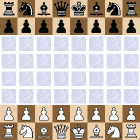In this variant the board deteriorates quickly. You want to have empty squares that you can move into, but you also want to keep in mind that if a player cannot make a legal move it is stalemate, ie the game is a tie (18% of the games ended in tie according to Brainking.com statistics). The initial queen move of the king is quite important, and you do not want to use that move unnecessarily. If the king has already made its first move, it is very likely that it will not be able to move when given check next time, since the squares get used up very quickly. At some point players end up having to move any piece they can, and this can be used against them.
[Site "BrainKing.com"]
[Date "2011.06.23"]
[White "Andres_Iniesta"]
[Black "Koksal"]
1. c4 c5 2. Nc3 Nc6 3. a3 e5 4. e3 Nf6 5. g3 h5 6. h4 e4

In the image, the red squares indicate the used up squares. Here black is trying to use squares which would normally be used by white, hence trying to gain some long term advantage. Also note that many times the rooks are pretty much blocked. Most times they stay in their original square, and sometimes they enter the game by capturing (or having to capture) a piece along their file when pawn exchanges open up that file.
7. Bh3 d5 8. Bxc8 Rxc8 9. Nxd5 Nxd5 10. cxd5 Qxd5 11. f4 exf3 12. Qxf3 Qe6

There is no need to exchange the queens just yet. White does not have many moves to play, but black should be careful not to cause a stalemate.
13. a4 a5 14. b3 b6 15. Qxc6+ Rxc6
White is going for the stalemate.
16. b4 cxb4 17. d4

This move quickens white's demise. Here, black moves and mates in 2. I missed this in the actual game for one turn. To see the solution, see black's 18th move.
.
.
.
.
.
Bd6 18. g4 Rxc1+ 19. Rxc1 Qxe3 mate 0-1
Here please see that the black queen is protected by the king (which can move as a queen, since it has not moved yet).














